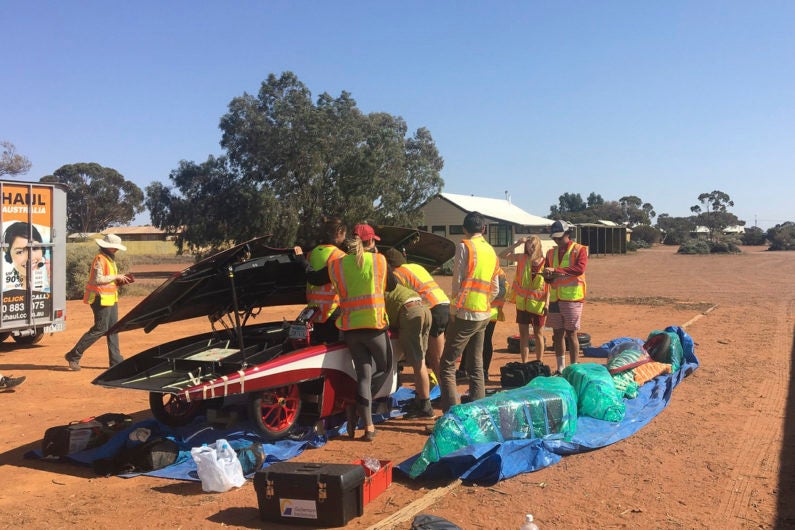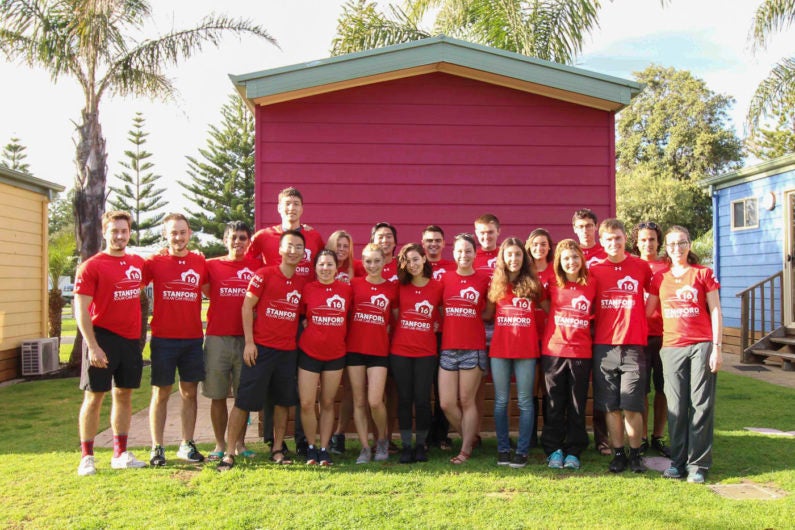Stanford Solar Car Project team to compete in Bridgestone World Solar Challenge in Australia
A solar car named Sundae developed by Stanford students is about to race more than 1,800 miles across the Australian Outback, testing the limits of cutting-edge technologies and undergraduate ingenuity.
“Population: Humans – 10, Cows – 50, Flies – 1,000,000.” So read the sign that greeted Stanford’s Solar Car Project team on entering Glendambo in the Australian outback. The 20 students and their car, Sundae, are making final preparations for the Bridgestone World Solar Challenge, to be held Oct. 8 against 41 other teams from high schools, colleges and universities around the world.

The Stanford Solar Car Project race team performing a mechanical check on the car at Glendambo during test driving. They are checking the state of the vehicle’s parts to make sure nothing broke after a test drive. (Image credit: Roman Decca)
The race, which has occurred every two years for three decades, is the oldest solar-powered car race, spanning more than 1,800 miles across the entire Outback from Darwin to Adelaide. A rule change limiting a car’s solar array size could make this year’s race the most challenging yet.
“This change required us to aggressively optimize Sundae’s aerodynamics,” said the team’s engineering lead, Max Drach ’17. “Sundae’s aerobody has 20 percent less drag at race speeds than our 2015 car, Arctan.”
The 32-member Solar Car Project team, which is entirely student run, had only 20 months to go from planning the car to racing it across the Australian continent.
“We are unique among solar car teams in our emphasis on student learning over race prowess,” said team lead, Kelsey Josund, a graduate student in computer science. “Although, obviously, we try to build the most competitive car we can.”
The most ambitious car
According race rules, each car can start with 5 kilowatt hours of stored energy, which is about 10 percent of what’s needed for the full journey. The rest must come from the sun or the car’s kinetic energy. That restriction, plus the new limits on solar array size, pushed the team to acquire cutting-edge technologies.
“The race rules are written to encourage us to use emerging cell chemistries and to work creatively with companies and research labs to get access to experimental materials and products,” said Josund. “Over the 30 years of solar car competition, the allowed technologies and the applications of them have kept pace with the field; our cars today use almost entirely different components than in the early days.”
These upgrades led to the car’s name, Sundae – it’s sweet, loaded with energy and has more than a few “cherries on top.”
As the team revised and downsized the car’s body to make it more aerodynamic, they tested ideas with a computational fluid dynamics software developed at Stanford, called SU2, with assistance from the program’s creators, Tom Economon BS ‘08, PhD ‘14 and David Manosalvas-Kjono, a graduate student in aeronautics and astronautics. In total, the students tested over 80 iterations of aerobodies.

The members of the Stanford Solar Car Project who are currently in Australia. (From left to right: Roman Decca, Gawan Fiore , Harrison Ho, Max Drach, Sarah Spaugh, Mike Chen, John Stayner, Jonah Sargent, Cori Brendel, Ben Fearon, Greg Lopes, Yuji Sugimoto, Auden Ehringer, Kelsey Josund, Ashe Magalhaes, Maggie Ford, Kate Pregler, Rachel Abril, Hayden Hall, Gillian Micale) (Image credit: Roman Decca)
They also turned to Stanford technology for the solar cells, working with Uytengsu Teaching Lab and Michael McGehee, a professor of materials science and engineering, to test manufacturing and design decisions, and develop ways of making the array more efficient at handling areas of shade.
Other advances include microcontrollers that communicate via Ethernet, which, makes it easier for Sundae to communicate with and track other cars, and advanced battery cells that were donated after a company saw the impressive mechanical design for Sundae’s battery pack.
On the road
Even for Josund, who was on the 2015 Arctan team, seeing Sundae drive at race speeds for the first time was a highlight of the current project. The students began these tests in August in California’s Central Valley to simulate outback conditions.
“Driving the car for be first time was really exciting and going over 50 mph for the first time was both exhilarating and terrifying,” said driver and battery team member, Auden Ehringer, ‘18. “And the fact of the matter is, you feel like you’re going very fast, even though you’re not, which is a lot of fun.”
Sundae’s streamlined dimensions accommodate a person no taller than 5 feet 1 inch. These diminutive drivers – of which there are four – sit close to the ground, and experience the world through a curved windshield that magnifies perceptions of speed.
Having traveled to Australia with Sundae, which had to pass quarantine with two tightly regulated battery packs, the team is now getting ready for the final test. The first car will leave the starting line at 8:30 a.m. local time on Sunday and the competition organizers estimate that the winner should cross the finish line by October 12.
“We’ve been anticipating this race for nearly two years now, and now it’s right around the corner,” said Drach. “Whatever happens during the race, the friendships I’ve made while working on the solar car will last for a very long time.”
Additional members of the 2016-17 Stanford Solar Car Project are: Rachel Abril, Jack Beasley, Cori Brendel, Mike Chen, Temidayo Dairo, Roman Decca, Kenyon Donald, Ben Fearon, Gawan Fiore, Steph Flamen, Maggie Ford, Hayden Hall, Harrison Ho, Ella Hofmann-Coyle, Reed Kraus, Christina Li, Greg Lopes, Ashe Magalhaes, Gillian Micale, Kate Pregler, Tarun Punnoose, Raymond Reynolds, Jonah Sargent, Eric So, Sarah Spaugh, John Stayner, Yuji Sugimoto, Abby Taussig, Sarah Woodard
The Stanford Solar Car project runs as a non-profit and is funded by a combination of in-kind, corporate and university sponsors. Its Premier sponsor is the Ford Automotive Company. The project’s University sponsors include the Associated Students of Stanford University, the Center for Automotive Research at Stanford (CARS) and REVS, John Etchemendy, Harry Elam, Persis Drell, the TomKat Center and the Precourt Institute for Energy.
